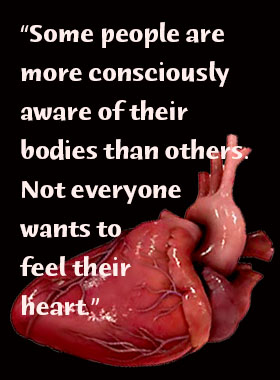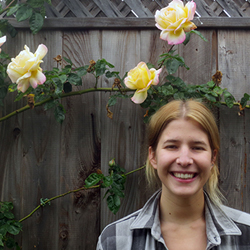
|
| Illustration: Elana Ryznar |
Tune in to an elusive internal sense, and you just might feel better. Jyoti Madhusoodanan has the inside story. Illustrated by Elana Ryznar.
Wolf Mehling noticed his breath for the first time at age 27. He’d spent three years battling a crippling pain that shot through his back and legs. When told by doctors the agony could only be cured with surgery, he turned to “breath therapy,” a form of alternative treatment popular in Germany in the 1970s.
The treatment, which made him focus on his breath, left him healed—and intrigued. Today, Mehling’s workspace at UC San Francisco holds no signs of a person disabled by pain. Floor-to-ceiling windows open the small office to a view of the crowded streets below. A thumb-sized Buddha perches on the window; a rolled-up yoga mat unfurls in the corner, as though it’s more accustomed to lying flat. It is unusually thick, the sort used by serious practitioners.
From the small room, Mehling, a physician and researcher, works with colleagues around the world to study how tuning into the body’s internal rhythms might help patients manage chronic pain. Knowing how we feel inside is surprisingly complicated. Our brains pack reams of information—from the outside world, internal organs, memories, and mental monologues—into an image of the body that’s tucked away in a tiny region called the insula. Being aware of this inner data stream taps into a little-understood feedback system called interoception.
Recent brain imaging research, patient studies, and data from interactive museum exhibits have converged to suggest that changing how we respond to interoceptive cues can ease mental and physical disorders, ranging from anxiety to anorexia to chronic pain. Studies show patients with eating disorders are less clued-in to their internal states. But others who are too acutely aware of these signals may panic in response to a galloping pulse or staccato breaths.
Revisiting these traumatic triggers, an infrequently used form of therapy, is surprisingly effective in patients with panic disorders. For others, simply focusing on physiological signs like their breath or heartbeat may help manage signs of anxiety.
Our consciousness of these signals can be tested in many ways, and researchers like Mehling are probing the best means to measure it. Whether quantitative tests can gauge this elusive inner sense of our bodies’ ebbs and flows is an open question. But even without a firm answer, we can tap into—and control—how we feel about our bodies. Interoceptive awareness starts with knowing where to focus our attention.
“Common sensation”
Begin by forgetting the five senses. When looking inward, we’re wired to sense our bodies differently. Receptors in every organ constantly check in: Heart pumping as usual? Lungs expanding enough? Blood sugar levels normal? And so on. We don’t consciously think about these signals. But your blood sugar dips, your stomach rumbles, and suddenly, you’re distracted in a meeting. Interoceptive signals ping your conscious awareness: Time for lunch.
Even deprived of familiar sights and sounds, we know what these cues are. Pain, hunger, thirst, gasping for breath, and the need to urinate are all universal, familiar interoceptive sensations.
“There are quite a lot of sensory receptors inside the body that we forget about,” says psychologist Vivien Ainley of the Royal Holloway University of London. “They’re quite silent most of the time. We don’t think about them until we get a terrible stomachache or something.”
Scientists have struggled to define this cluster of feelings for centuries. In 1846, German physiologist Ernst Weber lumped them under the term Gemeingefühl, meaning “common sensation,” in his book The Sense of Touch and Common Sensibility. Later, British scientist Charles Sherrington coined the word “interoception.”

Illustration: Elana Ryznar |
|
Even bright pink-and-blue interactive exhibits at science museums use the word. Two years ago, Ainley and her colleagues created a participatory exhibit at the Science Museum in London. Museum visitors placed their wrists on a sensor that checked their pulse. They were asked to count their own heartbeats, independent of the instrument. The scientists then matched up the numbers to see how clued-in people were. The results, published in the journal Psychophysiology in 2012, found some volunteers were much better at counting their heartbeats.
An exchange with one elderly couple at the museum stands out in Ainley’s memory. “The lady looked at me and said, ‘How on earth would I know what my heart is doing?’ And her husband of 40 years replied, ‘But of course you know. Don’t be so stupid, everybody knows what their heartbeat is.’ He had always been able to hear his heart, and she had never been able to hear hers.” Labs around the world use the heartbeat test to assess people’s awareness of internal cues, Ainley notes.
Questionnaires are another popular method. In 2012, Mehling’s group at UCSF’s Osher Center for Integrative Medicine created one that assesses how well people perceive—and respond to—sensory cues from inside the body. Published in the journal PLOS ONE in 2012, it’s called the multi-dimensional assessment of interoceptive awareness, or MAIA. (Mehling pronounces it ‘Maya,’ what he would have named his third child if it had been a girl.)
The 32-point survey is available online. Its questions traverse eight "scales" that assess various aspects of body awareness, such as worrying about pain or discomfort, regulating attention to bodily sensations, being aware of how emotional changes feel physically, and trusting and listening to signals from the body. With the MAIA, Mehling aims to measure how our capacity for this internal awareness shifts during pain or disease, or with treatments like yoga or behavioral therapy.
However we gauge our awareness of them, interoceptive signals appear to act like internal sentinels, waiting to alert us when things go awry. The system, present in most animals, motivates us to act on simple warnings of hunger, fatigue or pain. Eat until you feel full. Rest when you’re tired. Breathe deeply if you feel a lack of air. Even if we occasionally choose to work through lunch or stay up late, we’re all aware of these signals.
“We don’t know why it is that some people are a bit more consciously aware of their bodies than others,” says Ainley. “Not everyone wants to feel their heart.” Being hyper-vigilant of cues like heartbeat isn’t necessarily positive, she explains.
Changing mind, changing body
Indeed, several studies have shown that people who suffer anorexia, bulimia or obesity fare poorly on the heartbeat detection task—even after their health improves. In one recent study, published last year in Eating Behaviors, women recovered from bulimia were less sensitive to their heartbeat. Psychologist and lead author Megan Klabunde of Stanford University hypothesizes that women with bulimia may require stronger internal stimuli to feel hungry or full. “They report eating until they’re uncomfortably full. Some are able to vomit on cue, frequently, which most people would find painful or disturbing,” said Klabunde. “Many also tend to excessively exercise.”
It isn’t clear yet whether the interoceptive deficit is a cause or a consequence of eating disorders. But if researchers can establish that link, therapies that target interoceptive awareness could help such patients.
They’re already used to treat patients at the other extreme. People who suffer anxiety, panic disorders, and post-traumatic stress disorder (PTSD) are often acutely conscious of interoceptive signals. A slight change in their pulse, breath, or a sense of suffocation can send sufferers crashing into a panic attack.
 During a session of interoceptive exposure therapy, as the treatment is called, a patient might be asked to pinch his nose shut until he feels his heart pound against his ribcage. Or she might be instructed to breathe quickly and heavily until she hyperventilates. By recreating the worrisome signals—and training people to control their conscious responses—interoceptive exposure can ease such disorders. During a session of interoceptive exposure therapy, as the treatment is called, a patient might be asked to pinch his nose shut until he feels his heart pound against his ribcage. Or she might be instructed to breathe quickly and heavily until she hyperventilates. By recreating the worrisome signals—and training people to control their conscious responses—interoceptive exposure can ease such disorders.
Psychologist Brett Deacon of the University of Wollongong, Australia, has used it to treat patients for more than 15 years. “Interoceptive exposure is the most effective procedure to help people experience their body sensations as safe and tolerable,” says Deacon. “It’s a very logical treatment.”
For some patients, relaxation techniques—less intense than interoceptive exposure—may be equally effective for anxiety. In 2007, a study published in the Journal of Consulting and Clinical Psychology compared the effectiveness of both methods in treating anxiety and panic disorders. Patients with panic disorders benefited significantly when their treatment included interoceptive exposure. But for people with generalized anxiety disorders, relaxation techniques were just as beneficial.
“Meditation and mindfulness teach you to be aware of your body sensations, and to look at them differently than you might otherwise do,” says Deacon. “That part is key, because anxious individuals are in the habit of trying to get rid of the sensations. If they can sit with the sensations and accept them, it can be quite helpful.”
Elephant in the room
Outside the clinic, relaxation techniques take the familiar forms of yoga and many kinds of meditation. Mehling’s collaborators at UCSF are conducting trials of some treatments, like yoga, to see how they alter people’s interoceptive awareness.
Norman Farb, psychologist at the University of Toronto, uses brain scans to spot how interoceptive awareness changes with meditation. In a 2013 paper published in Social, Cognitive and Affective Neuroscience, he found that the brains of people who completed an 8-week program in mindfulness meditation had greater activity in the anterior insula, a region of the brain that’s often considered an “interoception tracker.”
However, the higher brain activity only appeared when participants performed one interoceptive task—watching their breath—because they’d practiced it during meditation. “We’re still trying to figure out how paying attention to the body alters how we respond to internal signals,” says Farb.
Podcast produced by Jyoti Madhusoodanan. Click on arrow to play.
A 2008 study published in Psychophysiology led by neuroscientist Sahib Khalsa of UC Los Angeles found meditators did no better than non-meditators on the heartbeat test. But when asked how they had fared, meditators consistently rated themselves as being better. Do meditators merely feel superior about their capacity to feel inner cues, or is the heartbeat detection test flawed? It’s a bit of both. “There are limitations to the heartbeat detection test,” says Khalsa. “It’s not the most common practice cultivated in meditation techniques. And most people can’t actually feel their heartbeats at rest.”
Not having an ideal measure doesn’t imply interoception isn’t real. “It means that changes aren’t always showing up on these tests,” says Mehling. He thinks the MAIA questionnaire might better capture our sensitivity to inner cues by scoring multiple-choice responses to statements like:
I notice changes in my breathing, such as whether it slows down or speeds up.
I do not notice physical tension or discomfort until they become severe.
I listen to my body to inform me about what to do.
Meditators, says Mehling, may score higher with their ability to focus on sensations like breath. People with anxiety disorders might be markedly better at listening to their body, but worse at responding without worry.
Scoring the MAIA, however, isn’t as simple as penciling in circles. “It’s difficult to quantify something that you might or might not be aware of,” says Mehling. “In that respect this questionnaire is problematic. As all self-report measures are.”
Surprisingly few studies compare the many ways to measure interoceptive awareness. Khalsa, Farb and Mehling all use different techniques. They’re all aware of each other’s methods, but uncertain how their data match up. Because of this, each measure—heartbeat, respiration, a survey—only grasps one part of the elusive sense of listening to our inner selves.
“In many ways it seems like we’re in the early stages of the field,” says Khalsa. “We know we’re trying to describe an elephant, but we’re only dealing with little bits and pieces. The question is, can we assess the data and get the full picture?”
Tuning in
Undetected by our conscious responses—or the multitude of lab tests—our bodies and brains continue to track and maintain our inner equilibrium. Not all of us can sense our heartbeats or observe our breath without changing it. And though anyone can take the MAIA, it’s hard to know what your scores mean. How do we sense this inner universe?
For a quick snapshot, try taking a walk. Take a deep breath, and feel your lungs expand with air. Feel the cold against your cheeks. Now run, as fast as you can, until your muscles scream in agony. Notice the pain as you drop your hands to your knees and bend over. Focus on the erratic pounding of blood against your eardrums. Feel your skin grow hot as blood rushes through the veins beneath.
This is interoception amplified. It’s what your organs and your subconscious brain are aware of, every minute of every day. The softer, routine refrain may not draw your attention as the mad dash did. But it’s what tells you the answer when someone asks, “How do you feel today?”
Someday, knowing how your brain arrived at the response might pave the way to new therapies for both mind and body. Stay tuned.
__________
Sidebar: A Different Inner Self
Fifty-nine-year-old “Roger” has lived in America all his life, but he has no memory of 9/11. He’s confused by pictures of the planes crashing into the World Trade Center, and he thinks it might be a Russian attack. He doesn’t know he can’t remember.
More than thirty years ago, while working at Yellowstone National Park, Roger suffered a herpes simplex infection. The severe brain inflammation left him in a coma for 9 days. When he woke, he was no longer capable of forming new memories. He’d also lost his sense of smell and taste. The viral infection destroyed regions of his brain considered critical to interoception, including the insula, anterior cingulate cortex and the medial prefrontal cortex.
After he recovered, Roger lived with his parents for years, before moving into an assisted-care facility. He still enjoys competitive bowling and listens to old vinyl rock albums. He remembers songs and artists he heard before his injury with ease.
For the last 14 years, he’s also worked with researchers at the University of Iowa who study how we create a sense of self. Even without memory, smell or taste, Roger retains a strong awareness of his own body. He recognizes himself and relatives in photographs, and describes himself as “a normal person with a bad memory.”
“Most people who meet [Roger] for the first time have no idea that anything is wrong,” the researchers write. “They see a normal-looking middle-aged man who walks, talks, listens, and acts no differently than the average person.”
Many of the regions of his brain damaged by the infection are the same ones activated when people perform interoceptive tasks, like detecting their heartbeat or breath. Even in their absence, when treated with a drug called isoproterenol which mimics the effects of adrenaline, Roger can sense changes in his heartbeat.
But he completely loses this interoceptive awareness when treated with lidocaine, which blocks signals from skin nerves to the brain. He may perceive internal cues through superficial sensations like the pounding of his heart against his chest wall, or his chest expanding against fabric, the researchers think. As a result, his brain still senses these visceral cues. Since the signals are processed even in the absence of most of the classical regions linked to self-awareness, they propose these regions aren’t as critical as once thought.
Instead, the group’s research suggests wider networks spread across disparate parts of the brain—including the brain stem, thalamus and somatosensory cortex—also may perform the essential function of interoception. Our sense of self, in other words, may be rooted across vast swaths of our grey matter.
© 2014 Jyoti Madhusoodanan / UC Santa Cruz Science Communication Program
Top
Biographies

Jyoti Madhusoodanan
B.S. (biochemistry) Gujarat University
M.S. (biochemistry) Majaraja Sayajirao University of Baroda
Ph.D. (biomedical sciences) State University of New York, Buffalo
Internship: The Scientist
I grew up across India in six different cities. With each move, I constructed mental landscapes of home by asking endless questions about everything around me, from plants, rocks and weather patterns to festivals, languages and diverse lifestyles. Factual answers grounded my perceptions of these changing geographies.
The joy of inquiry led me across continents to graduate school, where I tracked a viral hitchhiker through bacterial genomes using DNA sequences and electron microscopes. However, turning data into research papers left me unsatisfied. Over time, I learned that the nuances that completed my childhood explorations were people: their histories and their journeys to fathom the places we lived.
Finding these human elements of scientific discovery captivates me. Every question-filled trip reveals another personal tale of science—and takes me home to a new story.
Jyoti Madhusoodanan's website
. . . . . . . . . . . . . . . . . . . . . . . . . . . . . . . . . . . . . . . . . . . . . . . . . . .
 Elana Ryznar Elana Ryznar
B.F.A. (fine arts) School of the Art Institute of Chicago
In the short history of my life, I have been struggling to choose the greater of the two great disciplines of art and science. In early years I found myself in pursuit of science; I spent my middle school summers in the Caribbean at marine biology camps, gearing toward a future career. In college I found myself pursuing drawing, painting and art history. I still found time for science, holding internships at the Field Museum of Natural History and the John G. Shedd Aquarium. Now, my path has led me to California, where I found the resolution to my struggle: scientific illustration, a perfect union of art and science!
Elana Ryznar's website
Top |

